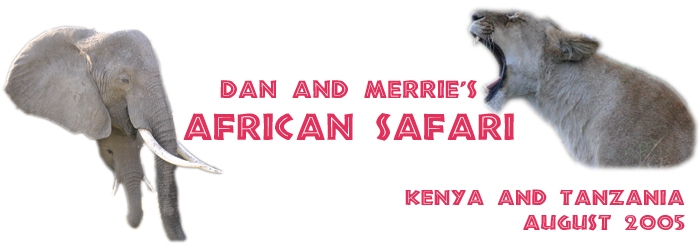|
|
A banded mongoose looks alert on the side of the road. These are the mongoose of snake-hunting fame; they can be ferocious in large groups and have a remarkable resistance to most snake poisons.
|
|
|
This is his cousin, the slender mongoose. If this little guy sees a snake, he takes off; he's not hunting anyone.
|
|
|
Our guide (Yusuph) eats with the other couple on our Tanzania trip, Bill and Val (British folks, like our safari friends from Kenya).
|
|
|
Hyrax were common on the few sparse rocks or buildings that were scattered throughout the Serengeti.
|
|
|
A martial eagle relaxes between flights.
|
|
|
The leopard in this picture is less-than-obvious, which is why it's so hard to find leopards in general.
|
|
|
This picture gives you a better view.
|
|
|
A group of hardebeest graze, although one of them usually has an alert head raised, smelling and listening for nearby lions.
|
|
|
Another leopard looks our way and gives us a better photo op.
|
|
|
The baboons were great fun to watch; this group had two little babies who really wanted to climb the tree, and mom had to keep pulling them back down to keep them safe.
|
|
|
This crocodile didn't move an inch in the two days we were in the park. Crocs can be nearly dormant for months at a time and can go as long as a year without eating, and are thus less-than-lively most of the time.
|
|
|
A mating pair of bee-eaters.
|
|
|
Another Masai giraffe; they were common in just about every park we visited, and even in the rural areas between parks and on the outskirts of the cities.
|
|
|
A lioness takes advantage of the early morning light to look around for prey.
|
|
|
This was the largest pride of lions we saw, at least twelve lionesses.
|
|
|
A zebra looks our way, while a few Thomson's gazelles graze in the distance.
|
|
|
A bachelor herd of impala graze, trying to get tough and huge before the mating season.
|
|
|
A marabou stork gathers sticks for a nest.
|
|
|
A baby croc sits around doing nothing, just like the adults do. Crocs have weak muscles for opening their jaws and incredibly strong muscles for closing their jaws, so it's not unusual to see them sitting around with an open mouth.
|
|
|
When we stopped to take a picture of a topi, our guide got a call on the radio letting us know that...
|
|
|
...a cheetah and her cubs were out just a couple miles away.
|
|
|
Mom walks along the top of a ridge, loooking for a safe place to hide with the cubs.
|
|
|
She settles into this shady ridge...
|
|
|
...and all the cubs follow.
|
|
|
Something has caught the attention of this family of hardebeest; everyone is heads-up.
|
|
|
A mating pair of lions rests during their three-day mating period.
|
|
|
Maybe a hundred yards away, the mating lioness's sisters wait for her to return after mating. The male had probably just arrived to choose one of the females a couple days earlier.
|
|
|
A herd of Thomson's gazelle grazes, but someone is usually looking up for approaching cheetah. They're too small for lions and even leopards to bother with, but they're the preferred prey for cheetah.
|
|
|
A large elephant, just a few feet from the road.
|
|
|
A baby elephant enjoys playing with this small log.
|
|
|
Just under the water is this hippo's little baby, but it was nearly impossible to get a picture. Baby just stuck his nose an inch out of the water once every few minutes, not much of a photo op.
|
|
|
We saw virtually no wildebeest in this park; several million of them had headed north to the Masai Mara a few weeks earlier. But we did see this one straggler, probably recovering from an illness, heading slowly north to catch up.
|


